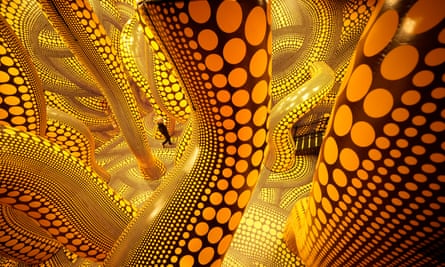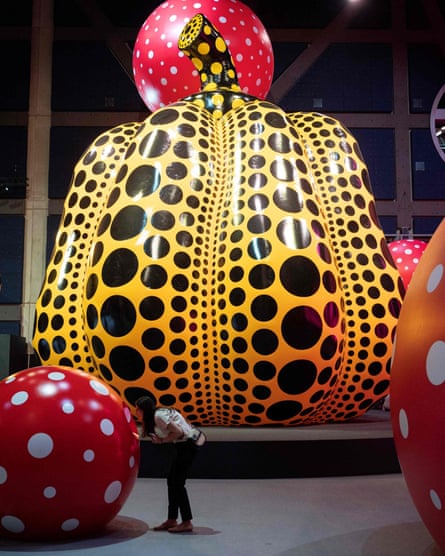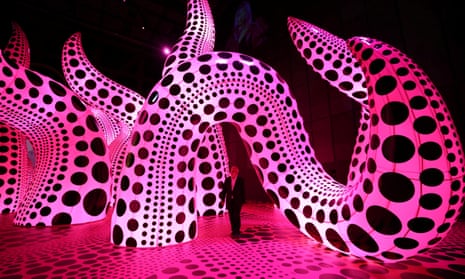Clearly the architects didn’t get the message that Manchester’s new arts venue Factory International has been renamed, boringly, as Aviva Studios. Because despite the new moniker I can still picture its ultimate inspiration, Tony Wilson, regional TV reporter and founder of the city’s legendary Factory Records, standing on the raised viewing platform in its colossal space, the Warehouse, pretending to be Andy Warhol, looking down on tiny people dwarfed by multicoloured inflatable artworks, pleased that Manchester has finally turned into his fantasy version of Warhol’s New York.
The Warehouse is a monster of a room that seems to have been inspired by staring at the enigmatic covers of Factory Records LPs while listening to Joy Division. It is an enormous industrial cavern with giant steel doors and towering, shadowy dimensions that appears equally capable of hosting art, gigs or a club. Yayoi Kusama’s opening event You, Me and the Balloons has aspects of all three. The 94-year-old pink-haired artist appears on a screen chanting above a forest of luminous purple tentacles. In front of this loom a gargantuan orange pumpkin, a giant statue that resembles Kusama with a skirt made of fat fingers, yapping dogs and lurid clouds.

Everything in the show is a light airy inflatable, so scale is practically limitless. That’s good because this place is vast. It is the north-west’s answer to the Turbine Hall – but it’s been a while since anything in that space was as much fun as Kusama’s psychedelic party. Some people are chilling on giant inflatable cushions, others are queueing to see themselves reflected infinitely inside a sphere.
It’s like an octopus’s garden in the shade (sorry, wrong city). You enter through a colossal vestibule, painted orange and black in a writhing pattern of interwoven filaments. It’s enchanting, this orange cephalopod-infested chamber. You find yourself hoping there’s more of the same to come. Climbing a black steel staircase, you discover there is indeed. From the gantry it is like looking over a pop art Garden of Earthly Delights.
Kusama started her career in 1960s New York – moving there from Japan (via Seattle) in 1958 – and with Warhol, Lichtenstein and Oldenburg gone perhaps she is the last proponent of a certain kind of pure urban pop. Kusama has claimed that both Warhol and Oldenburg pinched ideas from her. Whoever did what first, this gathering of all her works in the inflatable medium has clear connections with them. The mysterious skyborne forms suspended from a ceiling that’s almost too remote to discern have a lot in common with Warhol’s Silver Balloons. The giant soft pumpkin reminds you of Oldenburg’s colossal saggy stuffed objects such as his Floor Burger.

But Kusama’s objects are not the standard pop things. She doesn’t do burgers and soup cans. She prefers pumpkins. Why does this object obsess her? In this show she seems to be a careful student of nature, looking attentively at vegetables and molluscs, natural forms that are irregular, alien, slightly freakish: the inflated pumpkin has a majestic contentedness to it, a stupid happiness.
The shapes of Kusama’s art are not its only constituent, and perhaps don’t even matter. Everything here is teeming with dots that expand and contract in flowing highways and close constellations. When she arrived in New York in the late 1950s the city’s most celebrated artists were the abstract expressionists. She, too, is an abstract artist but she replaces the impassioned hurled paint of Jackson Pollock or Mark Rothko’s tragic stains with a disciplined system of dots that can be extended into any medium and fill this entire behemoth of a place with her artistic imprint.
Is it just a trademark? Kusama’s style has become a routine presence at every art fair and biennial. Her pumpkins in particular can seem an omnipresent bore. I find her reflective Infinity Mirror Rooms, including the one in this show, pretty vacant: infinite mirrorings of nothingness. You too may suddenly wonder if any of this has any meaning – at least, a meaning that can justify the scale and expense.
Well, welcome to modern art. If it didn’t seem slightly vacant it could not say anything about the way we live now. This is what Kusama has in common with Warhol, and if he did plagiarise his cow wallpaper from her, it only proves the affinity. The bravest pop artists are prepared to seem totally idiotic in order to make an art that’s truly of our culture. Kusama’s inflatable dolls and Alice’s Adventures in Wonderland innocence may make her almost indistinguishable from consumerism but at this scale, in this setting, the intensity behind the silliness looms in the balloon forest.

In its generosity, the inflation of Kusama’s vision expresses a desperate, unguarded need to be understood. As is well known, she has lived voluntarily in a psychiatric hospital in Tokyo since 1977. In this exhibition her feel for the stranger forms of nature is reminiscent of another artist who spent time in an institution. Vincent van Gogh also saw wavy, irregular natural forms as reflections of his being. Kusama’s pumpkins previously seemed commercial to me, but on this sublime scale this flabby enigmatic vegetable is a pop answer to Vincent’s Sunflowers.
Kusama goes big to achieve something simple. You, Me and the Balloons is exactly what its title declares. She wants to reach out, to be felt, to be understood. It’s the artistic impulse at its least veiled. The bigness is a largeness of heart. You sense that, and feel happy, satisfied, alive.

Comments (…)
Sign in or create your Guardian account to join the discussion